In Connecticut mice, voles, chipmunks and moles cause damage to gardens, fruit and other plantings. These species include house mice, (Mus musculus); white-footed mice and deer mice, (Peromyscus sp.); meadow voles, (Microtus pennsylvanicus) and pine voles (Microtus pinetorum), chipmunk (Genus Tamias) and true moles (from the family Talpidae).
Mice, voles, and chipmunks are more common than moles (burrowing, insectivorous, nearly blind and furry mammals), shrews (related to the moles and distinguished from them and the mice by a long pointed snout and very small eyes) and rats (larger than mice, with total body length from 15 to 17 inches).
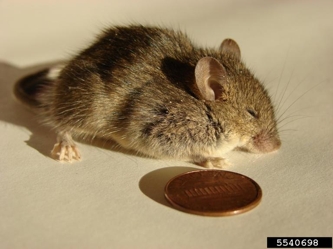
House mice are tawny to dark gray on the back, gradually changing down the sides to ashy gray on the abdomen. Their feet are shorter, broader and much darker than those of white-footed mice. Their tails are as long as their bodies but are shorter and less hairy than white-footed mice tails.
In general, mice can cause much damage because of their physical capabilities. They are excellent climbers and swimmers. House and white-footed deer mice can run up almost any vertical, roughened surface and climb and balance on wires. Their chewing of electrical wires may start fires. Mice can jump one foot straight up, live in temperatures as low as 14ºF and squeeze through an opening slightly larger than 1/4 of an inch. Their sense of smell is acute. In six months, a pair of house mice can eat about four pounds of food while excreting some 18,000 fecal droppings or pellets. Although mice are not blind, they do have poor vision and are unable to see clearly beyond six inches.
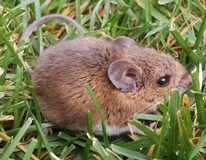
In considering control measures for mice, it is important to know where they live and how they feed. Mice live in grassy or bushy areas, nesting underground in shallow burrows or aboveground in densely vegetated or protected areas. Also, they can build nests in thick hay or leaf mulches in the garden or cropping areas. Nocturnal feeders, mice are active throughout the year. They forage along narrow surface runways from their nesting areas to their sources of food. In addition, they travel and feed underground via old mole tunnels.
The bark and roots of young trees are gnawed and severely damage by mice. Ripening tomatoes, cucumbers, beans, peas and other fruit close to the ground are bitten into. Developing roots or tubers of potatoes, carrots, beets and parsnips are dug into and eaten by mice, as well. Mice often invade homes or sheds in the fall. In wintertime, their runways are made below the snow cover where they dig up and eat seeds, nuts and bulbs. They feed on tender bark and foliage of shrubs, roses and small fruits such as blueberry.
White-footed and Deer Mice
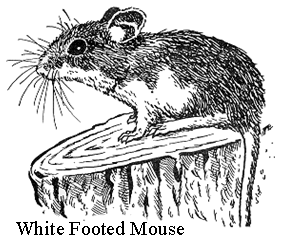
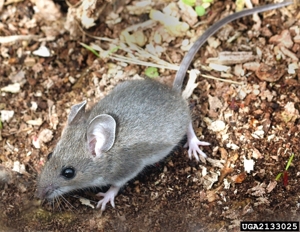
White-footed mice, the most common species, and deer mice have white feet and abdomens, large ears and eyes, and tails as long as their bodies. The color of the sides and back of these mice varies from dark gray to nearly black. They weigh 50% more than house mice and lack the mousy odor of house mice.
White-footed mice are commonly found in diverse habitats including open, grassy, brushy and wooded areas. They spend the winter as a family group in a nest made of stems, leaves, sticks and roots and lined with fur, feathers or shredded cloth. Nests are found underground or in protected areas such as old burrows, under boards, hollow logs or buildings. Breeding occurs from spring to fall, with two to four litters of one to eight young per year. Mice born in spring or summer may breed that same year. White-footed mice feed in an area from 1/3 to 4 acres.
Control
- Use good cultural methods to enable planted seed to grow as quickly as possible. Newly-seeded flats and seedbeds can be protected by placing 1/4 inch wire mesh cages or small plastic strawberry-type baskets over seeded areas. In the field, make sure edges are buried several inches into the soil. Cages can be made large enough to protect small trees, blueberries and other shrubs.
- Cages should be at least 1/2 to one inch from the trunk. In the field, stake, trellis or cage plants such as peas or tomato to keep the fruit off the ground.
- Common snap-back mouse traps are effective to eliminate mice in homes or structures. Bait with oatmeal, peanut butter, cheese, sunflower seed, moistened rolled oats or cotton balls (for nesting material).
- Use many traps, check them daily, re-bait and reset as needed. Traps should be placed along the sides of runways and perpendicular to the runways.
- Gloves should be worn when setting traps to reduce human scent. Placing unset baited traps in runways for several days to allow mice to become accustomed to them may increase effectiveness when they are set.
- In out-buildings, such as barns, cats have been a popular method of mouse control for a long time.
- Although mice have an aversion to some odors and tastes, at present no repellents have been found to solve a mouse problem completely.
- The use of frightening sounds is not effective in field situations.
Voles

Meadow voles, commonly known as meadow mice, are stocky with small, but prominent, beady black eyes and almost concealed ears. Their short tails are about twice as long as their hind feet. Meadow voles are five to seven inches long at maturity and weigh twice as much as house mice. Their dense, shaggy fur is gray to brown with gray under-parts, sometimes mixed with yellow or buff.
Their close relative, pine voles or pine mice, have smaller bodies, shorter tails, sunken eyes and underground burrow homes. Pine voles feed on plant roots and crowns.
In Connecticut, meadow voles are more abundant and destructive than pine voles. Meadow voles eat a wide variety of crops and plants, with a preference for grasses. When vole populations are high, many field crops are eaten. Their extensive tunnel systems cause root destruction and interfere with crop irrigation, as well. In late summer and fall, voles store seeds, tubers, bulbs and rhizomes in their tunnels. Voles are active day and night the entire year. They construct a complex tunnel system with surface runways and numerous burrow entrances. A single tunnel system may contain several adults and young. Voles have short life spans, ranging from two to sixteen months. Breeding occurs primarily in spring and summer, producing from one to five litters of three to six young per year. Females mature in 35 to 40 days.
Control
- Eliminate weeds, ground cover and crop litter in and around cultivated areas. This reduces the availability of food and cover for voles, and the capacity of these areas to support them.
- Euphorbia (spurge) and crown vetch may provide a deterrent when planted as borders around orchards, fields, and beds.
- Permanent sod strips between blueberry or raspberry rows must be mowed regularly. A weed-free or vegetation-free strip is an excellent buffer around areas to be protected. The wider the buffer strip, the less likely voles will cross it to the cropping area.
- Frequent tillage removes cover, destroys existing runways or tunnels and destroys a percentage of the existing population.
- Wire or metal barriers (tree guards) at least 12 inches high, with a mesh size of 1/4 inch or less around blueberries or trees, will exclude meadow voles. Bury the bottom edge six to ten inches to prevent pine voles from digging beneath the barrier.
- Mouse traps, or snap-back traps, can be very effective in reducing the vole population. Place the trap perpendicular to the runway with the trigger end in the runway. Apple slices or a peanut butter-oatmeal mixture makes good baits.
- A section of roofing shingle placed over the burrow opening and baited with an apple slice will attract voles. A trap can also be placed under this shingle, as voles are readily attracted to shingles or pieces of plywood placed on the ground. Shingles should be bent to form an A-shaped root. Plywood or flat material should have small blocks under the corners to allow for a crawl space. These shelters can also serve as bait sites. Leave in place a few days before baiting to allow the animals to become accustomed to it.
- In general, fumigants are not effective due to the complexity and shallowness of vole tunnel systems. Frightening agents have not proven to be satisfactory controls.
Chipmunks
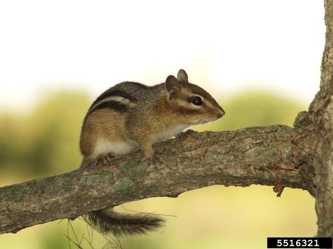
The eastern chipmunk is the only chipmunk found in Connecticut. It is reddish brown with a single black stripe running down the center of its back. A white stripe between two black stripes runs down each side of its body from the neck to the base of the tail. The chipmunk has a white underside and a white stripe above and below its eyes. Chipmunks range in size from 8 to 10" long (including the tail) and weigh between 2 to 5 ounces. There is no difference in appearance between males and females.
The eastern chipmunk is found in deciduous forests, shrub habitat, forest edges, and suburban and urban areas where there is abundant cover to protect it from predators. Chipmunks are omnivores, feeding on both plants and animals. Their diet includes seeds, nuts, berries, fruits, flowers, mushrooms, insects, worms, snails, frogs, bird eggs, and small birds. An enormous amount of food can be held in their cheek pouches, which can stretch to three times the size of the head. When gathering large nuts, chipmunks bite off sharp edges and stems.
Chipmunks can be a nuisance in the yard and garden where they eat flower bulbs, fruits, seeds, and seedlings. They also may cause structural damage by digging under patios, porch stairs, walls, or foundations.
Control
- Use 1/4-inch mesh hardware cloth to keep chipmunks away from gardens and flower beds.
- Ground covers, trees, and shrubs should not be planted in a continuous fashion connecting wooded areas with the foundation of the house.
- Avoid locating wood piles or debris near the house.
- Chipmunks are attracted to bird feeders where they gather spilled seed. Position bird feeders at least 15-30 feet away from buildings.
- Moth flakes or taste repellents may discourage chipmunks but usually requires multiple applications. Repellents should not be used on any plants intended for human consumption.
- Bait traps can be used, including peanut butter, nut meats, pumpkin or sunflower seeds, raisins, prune slices, or common breakfast cereal grains.
- Bait traps should be placed close to structures along the 'running' path of the chipmunk.
Moles

Moles are 6-8 inches in length, with extremely soft gray to brown fur. Of the six species that are found in North America only two are common lawn dwellers in Connecticut. These are the Eastern mole, (Scalopus aquaticus) and the star- nosed mole, (Condylura cristata). The Eastern mole is gray and has a nearly hairless short tail. The star-nosed mole has a long, very hairy tail and has 22 finger- like appendages surrounding its nostrils. The Eastern mole is the one most often encountered in home lawns.
Moles are small insectivores that live almost exclusively underground. While moles feed mostly on earthworms, they also will eat other sub-surface dwelling insects, such as beetle larva or grubs and a variety of nuts. The presence of moles in a yard does not necessarily indicate that grubs are present. To find out if this might be the case, check the areas where moles are actively tunneling to see if any grubs are present. The higher the number of grubs, the more tunnels may be seen as the mole or moles search them out. But keep in mind that moles are also found at the fringes of woods that are mostly hardwood trees. This is because the soils there may have many worms because of high organic matter content due to the breakdown of falling leaves.
Moles may actually reduce the number of underground insect pests of lawns as they can eat 70-80% of their weight daily but in doing so wreak havoc by their tunneling operations. Lawns must be tamped down continually to avoid root desiccation as roots hang in tunnels with no soil contact. Or lawns may be scalped when the pushed up grass is mowed, or as mower tires sink in the tunnels. If damage is great enough, homeowners need to take action.
Control
- A harpoon trap can work if used properly. Find the main travel tunnel by tamping down all, and see where the mole comes back. Usually all feeding tunnels come off the main tunnel. After determining this, the trap must be set so the supports straddle the tunnel and the harpoon prongs point directly over the main tunnel. If the supports block the tunnel, the mole will go around and avoid the deadly prongs. It helps if the prongs are worked in and out of the tunnel before setting the spring. This is so the mole will be hit quickly as the trap is sprung. When the trap is sprung, dig up the spot to make sure the mole is dead. If, not, re-tamp the tunnel lightly and reset.
- Toxins are contained in a bait. The most effective baits are sold as gummy worm- like articles that contain the poison bromethalin. These are inserted also into a long straight- run main tunnel. The key is not to leave your scent on them. A sharp stick can be used to open a hole into the tunnel into which the worm is dropped. Make sure the worm is not dropped too deep, so as to be beneath the main runway. Check daily to see if the worm was gone.
- Castor oil has been shown to have minor effectiveness when repelling a mole population but it may reduce their activity. In order for castor oil to be effective the entire lawn must be irrigated with 1/2" of water prior to the application. 1" of water should be applied post-treatment. Commercial concentrates are available or prepare your own castor oil concentrate by mixing 6 ounces of 100% unrefined castor oil with 2 tablespoons of liquid dish detergent and 1 gallon of water. Use a sprayer set at a rate of 1 ounce/gallon. This will cover about 300 square feet. Liquid products are more effective than granular. Castor oil has an odor that digging and burrowing animals dislike, the product itself is non-toxic.
- There are other mole killer baits on the market containing the active ingredient zinc phosphide. Protect non-target animals and humans from the bait as it has toxic properties if inhaled or consumed.
- Do not apply grub control products just because mole damage is seen. Check for the presence of grubs to see if that is the main reason moles are in the lawn. If your property borders a wood line, then moles may be impossible to control, but some success may be better than no success.
- Consider putting in a woodland garden consisting of native plants that will take the place of damaged lawn.
Despite good cultural practices, pests and diseases at times may appear. Chemical control should be used only after all other methods have failed.
For pesticide information or other questions please call toll free: 877-486-6271.
Revised by UConn Home and Garden Education Center 2016.